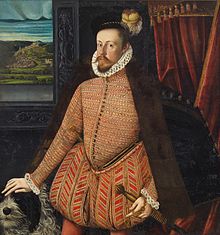
A peascod belly is a type of exaggeratedly padded stomach that was very popular in men's dress in the mid-16th and early 17th centuries. The term has been said to have come from "peacock,", though more likely it comes from the resemblance of the stomach shape in profile to a peapod, as "peascod" is an archaic form of the word. Contemporary plate armour copies this fashionable silhouette, which was sometimes called a "goose belly."
In the late 16th century the stomach of the doublet was padded to stick out, however, by 1625, the padding had become more evenly distributed over the chest area.
References
- Tortora, Phyllis G.; Eubank, Keith (2005). Survey of Historic Costume (4th ed.). New York: Fairchild. p. 175.
- "Peascod (archaic)". Wiktionary. Wikimedia. Retrieved December 29, 2024.
- François Boucher; Yvonne Deslandres (1987). 20,000 Years of Fashion: the history of costume and personal adornment (Expanded ed.). New York: Harry N. Abrams. p. 228. ISBN 0-8109-1693-2.
- Bradley, Carolyn G. (2001). Western world costume : an outline history (Dover ed.). Mineola, N.Y.: Dover Publications. p. 174. ISBN 9780486419862.
- Harvey, Sara M. (2008). "The Seventeenth Century". In Condra, Jill (ed.). The Greenwood encyclopedia of clothing through world history. Westport, Conn. : Greenwood Press. p. 125. ISBN 9780313336645.
- Harvey, Sara M. (2008). "The Northern Renaissance". In Condra, Jill (ed.). The Greenwood encyclopedia of clothing through world history. Westport, Conn. : Greenwood Press. p. 70. ISBN 9780313336645.
This clothing-related article is a stub. You can help Misplaced Pages by expanding it. |


